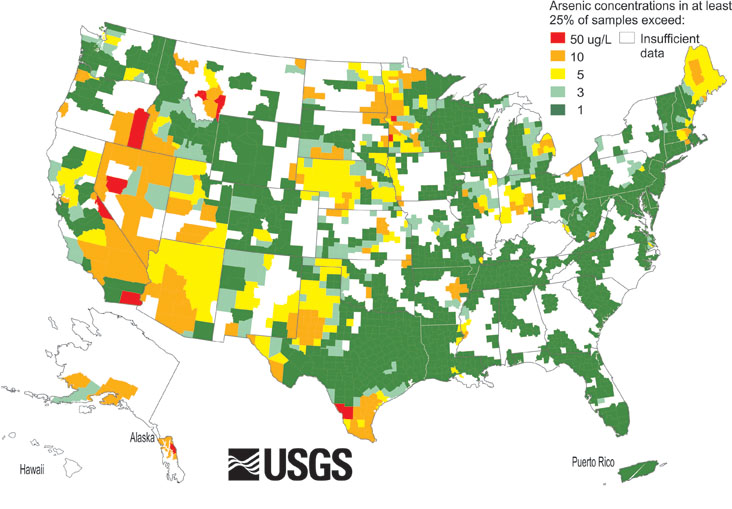Arsenic is found naturally in rocks, soil, water, and air. Most Arsenic is released into water by minerals dissolving from weathered rocks and soils.
The U.S. Geological Survey (USGS) estimates that at least 6% of all city water supplies do not the meet the 2006 federal drinking water standard.
Many private wells in Illinois also exceed the legal limit for Arsenic in drinking water. Some wells around Wonder Lake, IL may contain levels 2-3x higher than the EPA limit.
How Arsenic is Regulated
Cities must perform regular tests for water contaminants like Arsenic. If Arsenic is found, the city must notify residents.
The EPA has two standards for water contaminants:
Maximum Contaminant Level (MCL) – also know as the legal limit.
Maximum Contaminant Level Goal (MCLG) – the amount shown to have ZERO health risks (the ideal level).
Many water contaminants are measured and reported in “parts per million” (ppm). Arsenic is measured at MUCH lower levels in “parts per million” (ppb):
0ppb: MCLG for Arsenic (ideal level)
10ppb: MCL for Arsenic (legal limit)
Health Risks of Arsenic in Drinking Water
Arsenic is highly toxic and carcinogenic. Long-term exposure to low levels of Arsenic from drinking water has been proven to cause cancer in skin, lungs, urinary tract, bladder and kidneys.
Arsenic’s health risks have been heavily studied and well documented.
“Arsenic is one of the highest environmental cancer risks.”
– Arsenic Health Effects Program, University of California, Berkeley.
| Amount | Effect | Source |
| 0ppb | No Health Risks | EPA |
| 10ppb | Legal Limit | EPA |
| 11ppb | IQ deficit in children | Siripitayakunkit et al., 1999 |
| 20-91ppb | Artery, arteriole, and capillary disease | Engel and Smith, 1994 |
| 50ppb | Skin keratosis | Mazumder et al., 1998 |
Arsenic Water Treatment Options
Arsenic Water Treatment Options
Arsenic is colorless, tasteless and odorless in drinking water. The only way to know whether your water contains Arsenic is to have a sample scientifically tested.
EPA standards, and most state certified water tests do not break down what type of Arsenic you have, only the total amount.
Arsenic in drinking water is found in two forms:
AS3 – Arsenic 3, or Trivalent Arsenic. (this form has the highest health risk)
AS5 – Arsenic 5, or Pentavalent Arsenic
If your water has too much Arsenic, there are several options you can use to treat it:
| Technology | Arsenic 3 | Arenic 5 |
| Reverse Osmosis | — | YES |
| LINX Evolution | YES | YES |
| Arsenic Specialty Filter | YES | YES |
Reverse Osmosis
Reverse Osmosis systems use a special filter called a membrane to purify water. Membranes can reject up to 99% of ions in water. Arsenic 5 is removed very well by Reverse Osmosis. Arsenic 3, however, will pass right through a Reverse Osmosis membrane.
Arsenic Specialty Filter
There are different Filter Medias that have been made specifically to remove Arsenic. Our Whole House Arsenic Filter can remove both Arsenic 3 and Arsenic 5. Our company prefers LayneRT resin as it lasts longer, does not require flushing, and is lower cost than many competing medias.

